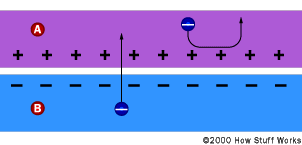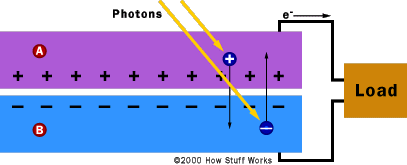Solar Cells
Shedding a little light on
photovoltaics -- 28 February, 2002
|
|
|
|
|
|
|
|
 Figure 1. The effect of the electric field in a PV cell (diagram courtesy of How Stuff Works ) The simplest solar cells have 3 active layers -- a top junction layer (made of N-type semiconductor ), an absorber layer (a P-N junction), and a back junction layer (made of P-type semiconductor). Thanks to the P-N junction, the cell has it's own built-in electric field. This electric field provides the voltage needed to force electrons and holes freed by light absorption to flow in their own directions (the electrons to the N-type side, and the holes to the P-type side). If we provide an external current path, electrons will flow through this path to their original (P-type) side to unite with holes the electric field sent there, doing work for us along the way. The electron flow provides the current, and the cell's electric field causes a voltage. With both current and voltage, we have power, which is just the product of the two.  Figure 2. Operation of a photovoltaic cell (diagram courtesy of How Stuff Works )
After a moment's thought, you can see that two additional layers must be present in a solar cell --electrical contact layers -- to allow electric current to flow out of and into the cell. The electrical contact layer on the face of the cell where light enters is generally present in some grid pattern and is composed of a good conductor such as a metal. The grid pattern does not cover the entire face of the cell since grid materials, though good electrical conductors, are generally not transparent to light. Hence, the grid pattern must be widely spaced to allow light to enter the solar cell but not to the extent that the electrical contact layer will have difficulty collecting the current produced by the cell. The back electrical contact layer has no such restrictions -- it need simply provide an electrical contact and thus covers the entire back surface of the cell. Additionally, an antireflective coating is generally applied to the top of the cell to reduce reflection losses, and a cover plate of some kind is often installed to protect the cell from damage while out in the real world. Now that we know a bit of what's going on inside
a solar cell, let's move on to see what
kinds of solar cells are available for us to choose
from. |
|
|
|
|
|
|
|
||
|
|
This page was last updated on |
|